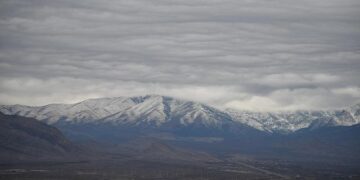In a groundbreaking new study, scientists have uncovered how just two pivotal human decisions dramatically altered the ecology and hydrology of the Great Salt Lake, reshaping its future in profound ways. Once a sprawling natural wonder, the lake’s delicate balance has been disrupted by choices made decades ago, triggering a cascade of environmental consequences. This revelation sheds new light on the intricate relationship between human activity and ecosystem health, emphasizing the far-reaching impact of seemingly simple decisions on one of North America’s most iconic inland seas.
Human Water Management Choices Transformed the Great Salt Lake Ecosystem
Two pivotal decisions by human stakeholders drastically altered the natural balance of the Great Salt Lake, setting off a cascade of ecological transformations that scientists are only now fully understanding. The redirection of freshwater inflows for agricultural irrigation coupled with the construction of causeways blocking natural water circulation reshaped the lake’s salinity levels, aquatic habitats, and migratory bird patterns. These choices, initially intended to support economic development, inadvertently pushed the lake into a new ecological state, highlighting the delicate connection between human infrastructure and environmental stability.
Researchers emphasize the consequences of such modifications through key changes observed over recent decades:
- Elevated salinity: Isolated sections of the lake became hypersaline, favoring certain microorganisms while endangering others.
- Habitat fragmentation: Physical barriers disrupted natural water flow, limiting nutrient exchange and affecting invertebrate populations.
- Wildlife disruptions: Migratory bird species, reliant on specific wetland conditions, faced declining food sources and breeding grounds.
| Decision | Ecological Impact | Timeframe |
|---|---|---|
| Freshwater Diversion | Reduced inflow, increased salinity | Mid 20th Century |
| Causeway Construction | Restricted circulation, habitat isolation | 1959 |
Researchers Uncover Long-Term Environmental Impacts of Limited Decision Making
Recent studies have illuminated how two pivotal human choices over a century ago drastically transformed the ecological fabric of the Great Salt Lake. By redirecting freshwater inflows and initiating large-scale water diversions to support agriculture and urban development, these decisions inadvertently set in motion a cascade of environmental shifts. The lake’s salinity levels rose sharply, reshaping habitats and threatening the survival of native species adapted to its previous conditions. This highlights the fragility of natural systems when subjected to limited but significant human interventions.
Key environmental changes identified include:
- Altered water chemistry leading to increased salinity
- Decline in brine shrimp populations impacting migratory birds
- Shifts in shoreline geography affecting wetlands and bird nesting grounds
| Impact Area | Pre-Diversion State | Post-Diversion State |
|---|---|---|
| Salinity (ppt) | ~30 | Up to 270 |
| Brine Shrimp Density (per m³) | ~800,000 | ~250,000 |
| Wetland Area (sq km) | 640 | 380 |
Experts Urge Strategic Policy Changes to Restore and Protect the Lake’s Future
Leading hydrologists and environmental policy experts emphasize that reversing the dramatic decline of the Great Salt Lake requires immediate, coordinated action focused on two critical human decisions: water diversion and land-use practices. The extensive rerouting of tributaries for agricultural and urban development has depleted the lake’s inflow, disrupting delicate ecosystems that depend on its saline environment. Experts warn that without revisiting water rights and implementing sustainable withdrawal limits, the lake’s ecological collapse will accelerate, threatening migratory bird habitats and regional climate stability.
To guide restoration efforts, specialists propose a multi-pronged strategy incorporating:
- Reallocation of water resources to prioritize natural inflows over non-essential industrial use.
- Enhanced monitoring frameworks to track salinity and water level fluctuations in real time.
- Community engagement initiatives promoting conservation and adaptive land management.
- Investment in infrastructure redesign to support ecological balance while respecting economic demands.
| Policy Target | Expected Outcome | Timeline |
|---|---|---|
| Water Rights Revision | Restore minimum lake inflows | 2-5 years |
| Salinity Monitoring Programs | Prevent ecosystem collapse | Immediate & ongoing |
| Community Conservation | Reduce water waste | 1-3 years |
| Infrastructure Modernization | Balance water use and habitat protection | 3-7 years |
Closing Remarks
As researchers continue to unravel the complex history of the Great Salt Lake, this study underscores the profound and lasting impact of human choices on natural landscapes. By identifying the two pivotal decisions that irrevocably altered the lake’s ecosystem, scientists highlight the delicate balance between development and conservation. The findings serve as a crucial reminder that even seemingly isolated actions can trigger widespread environmental transformations, prompting a reevaluation of how current and future policies might safeguard this iconic landmark for generations to come.

















![[News] Japan Develops 10nm Nanoimprint Technology, with Potential to Tackle EUV Bottleneck – TrendForce](https://earth-news.info/wp-content/uploads/2025/12/329851-news-japan-develops-10nm-nanoimprint-technology-with-potential-to-tackle-euv-bottleneck-trendforce-360x180.jpg)













